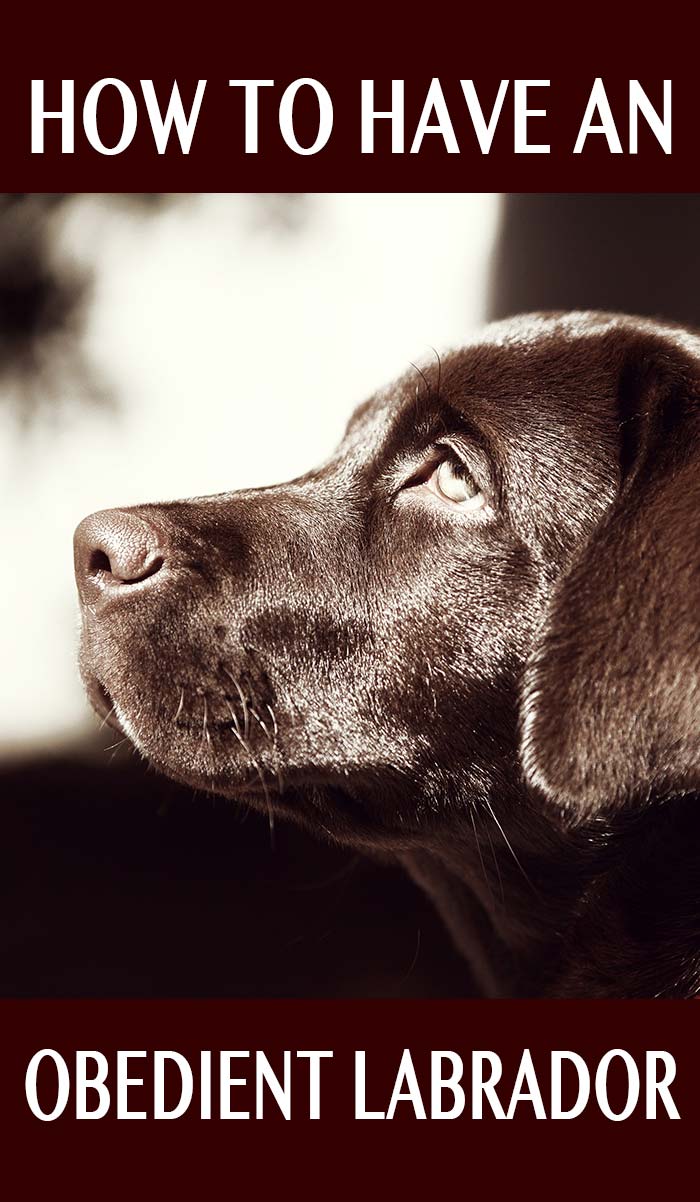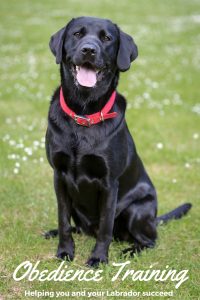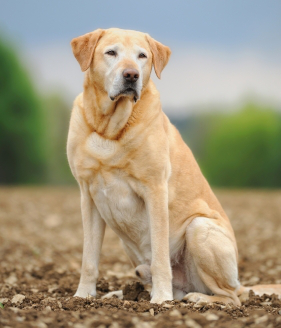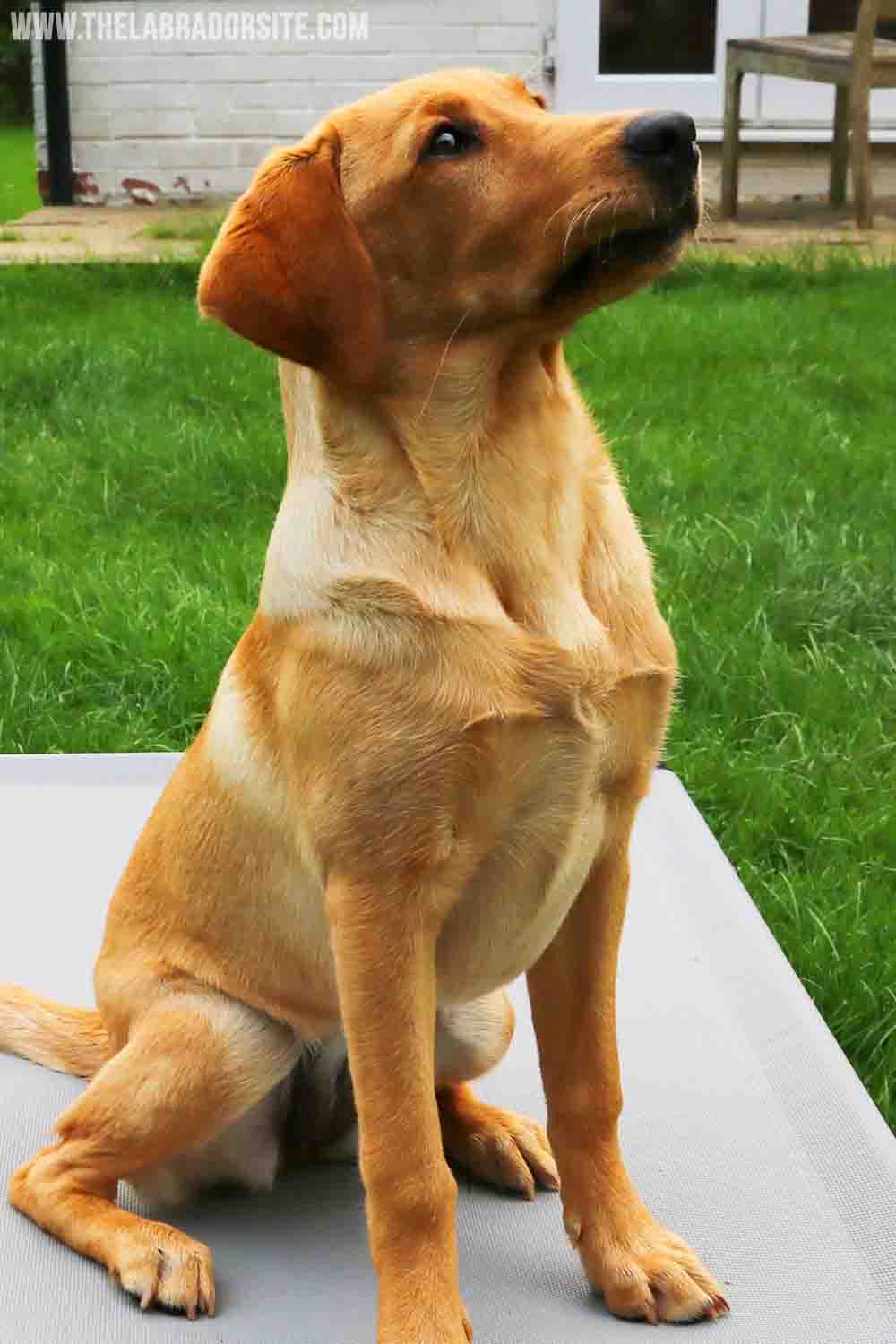Labrador Obedience Training
We focus on Labrador obedience training in this article, and show you how to have the obedient Labrador Retriever of your dreams.
CONTENTS
- What makes an obedient Labrador?
- What use is obedience training?
- How difficult is obedience training?
- How obedience training works
- Puppy obedience training
- Obedience training for older labs
- Reliable obedience training
- Proofing dog training
- Obedience training methods
- Why are dogs disobedient
- Achieving obedience with your Lab
- Training instructions
- PIN THIS ARTICLE FOR LATER
Labrador obedience training is not just for ‘serious’ trainers, it’s important for our pet Labrador Retrievers too. Let’s look at what’s involved in getting your dog to be the obedient friend you always wanted.
Isn’t your dog good!
How much we all admire an obedient Labrador. The dog who lies quietly by his owner’s feet in the pub, thumping his tail gently when people speak to him. The dog that sits patiently to be stroked when visitors arrive. And the wonderful warm feeling of pride when a passing stranger says “Isn’t your dog good!”
How do people achieve this kind of Labrador obedience? Is it good training, or is it just down to luck? Perhaps we first need to decide exactly what we mean when we talk about obedience or an obedient dog. Let’s start by defining what makes an obedient Labrador.
The obedient Labrador
Many dogs will sit when you say sit. But they won’t stay there very long. If you turn around and chat to someone, or if another dog passes by – they’ll get up and walk away. What separates an obedient dog from a disobedient dog is usually how ‘reliable’ his trained behaviors are.
Take the dog that lies down at a quiet word or signal from his owner, and remains there without moving, even when his owner walks out of sight or moves around, and even when children or dogs run past. That dog – I think we’d all agree – is an obedient dog. So how useful is obedience training, how difficult is it to achieve that kind of obedience, and can you do the same with your dog? Or is he beyond hope!
How useful is obedience training?
We often think of obedience training as something that people do in a ring, with judges watching and points being awarded. Or something that is only necessary for dogs that do a job of work, such as sniffer dogs, or guide dogs.

Obedience training can keep you and your dog safe
Large dogs that drag people around on the leash can pull an adult off their feet and into the road. Or knock people over by jumping up at them. A dog who won’t come when called is at much greater risk of getting injured or attacked than an obedient dog.
Obedience training makes you a proud Labrador owner
A disobedient dog is embarrassing and most importantly is not a welcome guest. Obedience training means that you can take your dog to many more places and give him much more freedom. So, the bottom line is: an obedient dog is a happier dog.
How difficult is obedience training?
Just how difficult is it to go from mischievous puppy to obedient Labrador Retriever, or from bouncy irrepressible teenage dog to calm and responsive adult? Actually, it is a lot easier than you think. But probably more time consuming too.
The reality is that there is no aspect of obedience training that a child over ten could not master. Modern training does not require strength or ‘leadership’ skills. Much of it can even be carried out from a wheelchair. What it does require, is time and commitment. On a regular basis. If you are willing to provide those two components you will find everything you need to obedience train your dog, right here on this website. And if you put the time in, and follow the instructions, you will get results.
How Labrador obedience training works
When we teach any kind of skill to our Labradors, be it walking nicely on a lead, sitting when told or coming when called, there are several distinct phases to this training.
- Teaching
- Proofing
- Maintaining
But what do we mean by ‘proofing’ and ‘maintaining’ – let’s take a look at what is involved in each of those phases.
Puppy Obedience Training
The first phase is the teaching phase. We sometimes assume that ‘good’ dogs just soak up the English language in the same way the children do, and learn to respond to people naturally. This is simply not true, and all dogs need to be deliberately taught how to respond to our voice and signals if we want them to be obedient.
Teaching basic commands or cues such as SIT, DOWN, and COME to a dog is relatively simple and for many of us this simple obedience training begins in puppyhood.
Obedience Training for Older Labs
Older dogs can be obedience trained too, and rescue dogs often need a solid course of obedience training to get them to respond to commands given by members of their new family. But the very best time to start obedience training is when a new puppy arrives in your home.
Reliable obedience training
The second phase in achieving an obedient Lab is the part where we teach the dog to respond reliably to the cues or commends that we give them. The part where your Labrador learns that SIT means SIT, no matter where he is, and no matter what else is going on around him. This part of the obedience training process is known as proofing.
Proofing dog training
Proofing is the process of teaching your Labrador that the word he has learnt to obey applies in lots of different circumstances.

Generalizing dog training
Usually new commands are taught at home and under conditions that are relatively low level of distraction or temptation to disobey.

All Labradors and dogs in general, are quite poor at understanding that a command or signal learnt in one set of conditions, also applies under other conditions or in other circumstances. We call this the ability to ‘generalize’ and it is something that people are very much better at than dogs. Some dogs are even worse at generalizing than other dogs. This gets them into a lot of trouble!
Proof dog obedience in stages
Every skill you teach your dog must be ‘proofed’ under different conditions. The sort of conditions that your dog is likely to come across in the real world. These conditions will include a range of ‘distractions’ or circumstances that might tempt your dog to engage in activities other than those you intend for him.
If your lab runs off to play football with some local kids when you have just whistled him back, it is because you have not ‘proofed’ your recall against children playing. And if you regularly exercise your dog where children play, this is a piece of proofing that you really need to set up without delay.
The most effective way to ‘proof’ your dog’s training is to introduce each distraction in stages beginning with the least powerful level of any given distraction, and culminating in the most powerful level of that same distractions.
Other dogs are a big distraction!
For example, many Labradors love other dogs. They rush up to everything and anything with four legs and a wagging tail, in the expectation of a game and some fun. Another dog is therefore a ‘distraction’ against which you must ‘proof’ your ‘recall’ and other trained skills. But the power of this or any other distraction will vary according to the activity level, and proximity of the other dog.
So if the dog in question is sitting quietly next to his owner on the far side of a field, that would be a far less powerful distraction than the dog which is racing around chasing a frisby twenty yards away.
Proofing obedience requires assistance
So you can see that proofing essentially involves setting up ‘fake’ situations of the kind you are likely to come across in the real world. The advantage of ‘mocking up’ a fake scenario, rather than waiting to stumble across real live situations, is that it enables you to ‘set the dog up to win’, and to control the consequences of his actions.
Proofing obedience training effectively does require you to get help. And this is what puts many people off. If you are going to teach your dog to recall away from children, you will need to ‘rope in’ some children to help you. If you are going to teach your dog to walk to heel past other dogs, again you will need to get help from a friend or friends with other dogs.
Some types of proofing can be carried out in training classes, but many classes take place indoors and as such are of limited value for proofing. Much better for many types of proofing are gundog training classes which take place outdoors and involve other dogs, and people in a real life environment.
Commands which are vulnerable to distraction
Two commands which are very vulnerable to distraction are ‘recall’ or the come command, and ‘heelwork’ or teaching your dog not to pull.
Many dog owners find that their dog’s recall is great until another dog appears over the horizon. Many other owners have no trouble getting their dog to walk nicely on a lead in the garden, but find themselves dragged of their feet within minutes of leaving the garden gate or whenever a passerby approaches. If this happens to you, it does not mean your dog is inherently bad, or difficult to train, it just means that you need to proof your training under a wider range of conditions.
How do I proof my training?
To proof training you must ‘set up’ relevant situations where you can control the outcome of your dog’s behavior. To proof your dog’s recall in the presence of ‘other dogs’ you will need to teach him to obey your recall whilst other dogs are present in controlled conditions.
This means starting with a well behaved ‘assistant dog’ sitting quietly on a lead, and progressing in gradual stages to recalling your dog away whilst he is actually playing or interacting in some other way, with another dog. This takes time and patience, and we will be bringing you some specific examples in future articles.
The importance of consequences
Dogs learn by the consequences (good or bad) of their actions. Controlling these consequences is the key to successful proofing. We need to ensure that your labrador receives a good consequence for obedience and that he never receives a good consequence for disobedience. The latter can be tricky to achieve.
Each time you increase the level of the distraction involved in training any skill, you should temporarily increase the level of reward that the dog receives for obedience. You will also need to ensure that the dog cannot reward himself for disobeying you. A training lead can be very helpful in achieving this aim.
Why do so many people have problems with proofing?
Proofing can be carried out using just the same Labrador training techniques as you did with your basic training. But it can be more complicated to set the dog up to ‘win’ when you are proofing, than it was when you were teaching in the absence of any distractions. It is for this reason, that many people give up on proofing or resort to more forceful methods than they did in the initial stages of training.
As you advance your proofing with more powerful distractions it can sometimes be difficult to control the environment in which you are training. This is particularly relevant when it comes to proofing against the distractions of wildlife in the countryside.
Dogs that have been bred to hunt or chase can be especially difficult in this respect. But if you are to be successful in proofing your commands, you will need to regain control of your dog.
Regaining control
There are definite advantages for those that are proofing with a young dog that they have had from a puppy. Dogs learn from their own experiences, and if you have had your Labrador from eight weeks of age, you will have been able to exert a lot of control over those experiences.
Rescue dogs can be more challenging in many aspects of training but especially where proofing is concerned. This is because they may well have been given plenty of experiences in the past where they were highly rewarded for disobedience, usually simply because the owner did not know how to control the consequences of the dog’s behavior.
To complete the proofing process successfully, you will need to regain control of the consequences of your dog’s behavior. Getting away with ignoring a recall for example, will need to become a thing of the past.
Although many adult dogs with poor obedience understand certain commands very well at home, sometimes it helps to retrain a command right from the beginning using a new ‘signal’ simply because the old one has come to mean nothing outdoors in the big wide world. Using a long training lead on a rescue dog is often a very good idea. The dog simply trails the lead around on the ground whilst running free outdoors, this gives you some control whilst allowing him some freedom
Getting help with proofing your dog training
There are many in depth training guides on this website and they all include detailed proofing instructions. You can also join our forum for help with proofing. Proofing takes time but is essential if you want your dog to understand your instructions in lots of different places, and under lots of different circumstances. Proofing teaches dogs to obey our instructions even when there are other dogs about, children playing, people to beg food from and so on.
Successful proofing is what separates those that achieve Labrador obedience, from those that do not.
Obedience training methods
Obedience training methods have changed considerably over the last few years.

It means we can train very small puppies instead of waiting until dogs are big enough to cope with obedience training. It also means that children who understand the process and are able to follow instructions, can learn to train their own dogs.
Not only are teaching methods different, modern proofing is very different from traditional proofing. There are two different ways to approach proofing.
- The challenge method (traditional)
- The reinforcement method (modern)
The challenge method
Traditionally, in obedience training, proofing was approached using the challenge method. Here is an example. The dog is taught to ‘sit’ in fairly undemanding conditions (a quiet back yard for example) then taken into much more distracting and tempting conditions where his obedience is deliberately ‘challenged’. In other words he is left there so long that he is tempted to move, or distracted sufficiently to make him move. When he fails to obey, which is inevitable, he is punished.
In this way the dog learns in time, learn that sit always means sit, no matter what the circumstances surrounding the command. Millions of dogs around the world have been trained using this method of proofing. So why have we changed things around?
The disadvantages of traditional training
Some trainers do still use the challenge system and it does work. There are however problems with a process which is essentially based on setting a dog up to fail. Many dogs require some quite severe punishment to achieve results, especially amidst powerful distractions. And dogs that are repeatedly punished do tend to become hardened to it, so that a spiral of escalating punishment sets in.
Constantly challenging a dog until he disobeys and then punishing him when he does, can undermine his confidence and his trust in you. Some dogs trained this way can appear quite ‘cowed’ and nervous. Nowadays this kind of treatment of dogs is not popular and the challenge method is beginning to fall into disrepute due to the harsh punishments that can be involved.
The reinforcement method
Modern dog trainers increasingly use positive reinforcement to train their animals. This involves deliberately setting the dog up to succeed, and rewarding him when he does so. It involves teaching dogs to obey a command in gradually more tempting and difficult circumstances with distractions being introduced carefully and increased in intensity little bit by little bit.
The dog is ‘set up to win’ and frequent success is guaranteed. Each success is then reinforced using rewards. This is the method of choice worldwide now for all professional dog trainers that take an interest in their own professional development. And for those that are committed to expanding their knowledge of animal behavior and their own training skills.
Why are many dogs disobedient?
One reason that many dogs are disobedient is that many dog owners do not know how to ‘proof’ their dog’s new skills. They often make a good job of teaching the skill at home and then are very upset when the dog’s obedience falls apart in public. What they are essentially doing is attempting the ‘challenge’ method, but usually without any effective form of punishment. And without punishment, the challenge method cannot work.
Those who attempt the reinforcement method sometimes fail to understand how to ‘break the process down’ successfully, or get frustrated and give up, when it takes longer than they expected.
Achieving Labrador obedience
Achieving an obedient dog means taking each skill you want him to obey and retraining it, bit by bit, in all kinds of different situations. It means taking each potential ‘distraction’ and thinking about how you can increase or decrease the intensity of the distraction for the dog.
Often this can be achieved simply by moving the dog further away from the source of the distraction. For example, teaching your dog to walk nicely on a lead past another dog would begin with a large space between the two dogs, and would work up to the two dogs walking within inches of one another.
With some skills and distractions this is quite complicated to set up, but it is essential to do so in order to succeed. Achieving Labrador obedience also means understanding what constitutes a distraction and making sure you train for all the distractions your dog is likely to meet during the course of an average week or month.
Common distractions include
- People
- Other dogs
- Wild animals
- Vehicles
- Cyclists
- Joggers
- Farm animals
- Extreme weather
- Extreme noise
You can probably think of others. In addition to distractions there are other factors of difficulty in any skill, factors like the duration of the task, the distance between the dog and handler when the command is given, and so on. All these must be introduced separately and increased incrementally for successful obedience to be achieved.
Understanding what proofing involves and what constitutes a distraction, enables dog owners to plan their training in a logical and structured way, and to introduce their dogs to increasingly challenging tasks in easy to achieve stages.
Maintaining your dog’s obedience
Once your dog is trained and his training is proofed he will be a joy to take out, and a source of great pride. But there is still one more task ahead of you. You need to maintain his obedience for the long term. And happily this is the easy part. The most common mistake people make is to stop reinforcing the behaviors they like.
It is easy to ignore the obedient dog, to forget to give him a tasty reward from time to time when he flies back to a toot on your whistle. Take the time to notice and reward your dog when he is being good, whether it is sitting quietly to be stroked, laying down next to your chair, or walking nicely at your side. All you need do is remember to continue to reinforce his best behavior from time to time and you will be assured of lifelong obedience from your loyal friend.
(Want to save this article? Pin it for later!)
Articles to help you with basic obedience
- How to train a dog to sit
- How to train a dog to come
- Train your labrador to lie down
- How to teach a dog to stay
- How to stop your dog pulling on the lead
- Labrador Training
- Dog and Puppy Training Guides
- Faking It – A Labrador Training Guide
- Gundog Training
- Recall Training
Obedience training tips
- 10 ways to reward your Labrador without food
- 5 ways to improve your bond with your Labrador
- Communicating with your puppy
- 3 reasons your Labrador is disobedient
- Help I have a naughty Labrador!
- How to cope with a naughty Labrador
- Guide to Labrador Puppies
More help and information


Free Labrador Updates!
Get my training tips, news, reviews, and the latest from The Labrador Site delivered to your inbox



Hi i have a 17 month old male lab im having trouble with him barking ive tried everything im at my wit ends can u plz give me some advice.
Hi Karen, Sorry to hear you’re having a tough time with your Lab’s barking! Here’s a guide I hope will help: https://www.thelabradorsite.com/labrador-barking/
I inherited a 7 yr. old black lab a year ago. He knows the basic commands but doesn’t always do them for me. When I take him for a walk I’m pulled until I feel my arm is coming off. He is now refusing to eat his food, seems to prefer the cats food. Can you help me?
Is is necessary to train your dog to heel on the left side or can I train my dog to heel on the right?
Hi Kay, It is totally up to you. Most right handed people find it convenient to teach their dog to heel to the left, as it gives them the dominant hand free, but it’s entirely your decision. Best wishes, Lucy.
I have 3+golden brown labrador it s really too much How can i manage ?plz help me.I am from ranchi.
hi. i have a 5 month old Labrador puppy. he is off white. i was able to teach him not to pee on our sit out and was also able to teach him to sit. but as soon he does that, he gets distracted and jumps off from my command. ill also be able to teach him further, but I’m not able to do so because of his non obedience. i tried soo much from information’s available on internet. but no use.. cause it doesn’t say how to strictly train my puppy.. so pls do help me
I have 3mnths old lab when it stars obeying my words
Hi
I have a 3 yr old choc lab who is very well behaved normally, however in the last 2 weeks or so he has started mounting other dogs when off lead. His recall is good but hardly ever stops humping the dogs when called off. He has never done this before, can it be a sudden new behaviour or maybe a medical condition causing this? ( ive heard it could sometimes be from urinary tract infection?) Some advice would be great as my vets aren’t brilliant.
Hey I have a 7 month old male lab retriever, I have tried and tried to teach him obedience but with no luck he just doesn’t do it. He is very energetic as would all puppies be, but he seems to me to have a lack of respect and basically just runs rings round me. Out walking he pulls, he runs after everything! Birds, leaves, people, dogs, any vehicle, heck even if the wind blows the grass he tries to catch it… He’s awful when someone passes, if he sees another dog he goes completely nuts and will stop at nothing to get to them.. To the point of knocking me down or biting for restraining him. I’ve tried averting his attention but that definitely doesn’t work… He knocks over the kids and pulls on their tops. He jumps up and he bits a lot, I thought this was mouthing but any time you put your hand out to pet him he tries to snap it. He has excited urination which has been a challenge to get over but we have managed that (sort of)…before we got him a read a tone of books and researched a lot on training but it’s just not worked… Is it me? I don’t believe harsh punishment works, plenty praise and plenty love and affection but when your bitten or nipped on the legs every time your back is to him, he tears into possessions and just runs a mockery I’m at my wits end! HELP!!!
I am in the exact same boat as you. My puppy is almost 6 months old. Still messes on the house. Will not go outside unless you’re with him. Can be outside for 30+ minutes bring him in and he will mess in the house. I’ve tried rewarding him when he goes outside. He doesn’t come when I say come, he doesn’t really pay attention when I say his name… I’m at my shots end- I’m in desperate need of help. My husband and is losing his patience and wants to get rid of him. It I do not. Someone please help me!!!!
Hello Team,
First time ever I own a pet at my home. i have a lab (Zooby) which is 2 months old and it is very naughty and playful. I’m following the training methods that you have mentioned in your site but not very successful. I would like to know when is the right time to train my pet and when is the right time (mature) for my Zooby to understand my instructions?
I take him out right after the meal. last week, Zooby has vomited the meal right after coming back from the walk. it is really concerning me. can you advice on this as well?
Thanks
Srikanth.
my lab is not barking at strangers what shall i do..
Be thankful that you have a nice, normal, friendly Labrador 🙂
My Prince DOB is 18th April 2013, I am from Kolkata,
1 While going for walk in the morning he pulls and struggles to go out later on he becomes normal..Please suggest.
2 Right below his left eye some rash had appeared ..Pl. suggest.
This may be a little off-topic but I can’t find any information on this anywhere else. Can I train my lab to tolerate increasing noise levels in our home with this reinforcement method? Gradually increasing his exposure to the noise until he is able to tolerate it in a relaxed state?
I ask because my son is a drummer and it can be quite loud even for me when he rehearses. I certainly don’t want to make our new rescue lab nervous or fearful because the drums are part of living in our household. Thanks!
I HAVE A 7 MONTH OLD CAVACHON (CROSS KING CHARLES SPANIEL AND BICHON FRISE). HE IS FINE AT HOME BUT WHEN WE ARE OUT AND WANT TO LET HIM OF THE LEAD IT IS STARTING TO BECOME A NIGHTMARE. IF HE SEES A BIRD HE RUNS OFF AND THERE IS NO WAY OF GETTING HIM BACK! MUCH THE SAME WITH ANOTHER DOG, PERSON, BUTTERFLY, ANYTHING THAT MOVES! ITS LIKE HE IS IN HIS OWN LITTLE WORLD AND WE DONT EXIST. I’M AT THE POINT NOW WHERE I CANNOT LET HIM OFF THE LEAD AS I AM AFRAID OF LOSING HIM, CAN YOU HELP?
Hi Maria, recall training is a long process, especially with a dog that has a previous history of chasing. Check out our recall training centre for information on recall training and control issues
Pippa